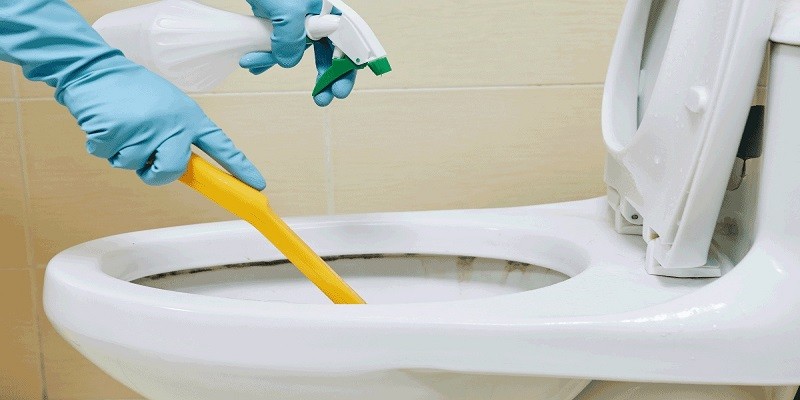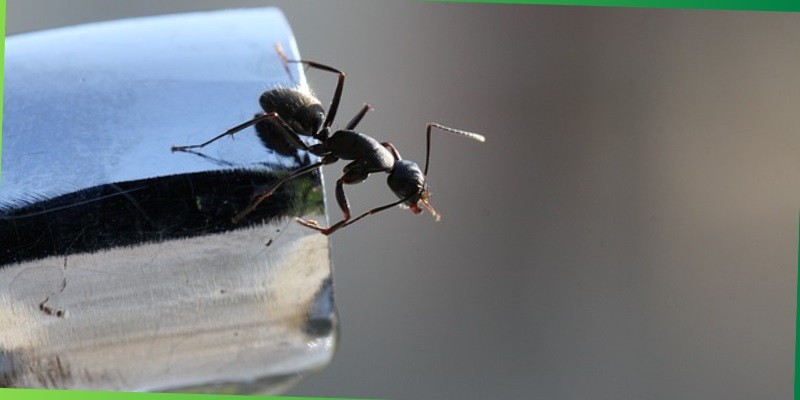Last Updated on November 13, 2023
To clean calcium buildup from a toilet, use a mixture of vinegar and baking soda. Calcium buildup in a toilet can be unsightly and difficult to remove.
However, by using a simple mixture of vinegar and baking soda, you can effectively clean and eliminate the stubborn calcium deposits. Calcium buildup often forms as a result of hard water, leaving behind white stains and residue in the toilet bowl.
This mixture works to dissolve the mineral deposits and restore your toilet to its original cleanliness. We will discuss the step-by-step process of removing calcium buildup from your toilet, as well as provide some additional tips for preventing future buildup.

Credit: www.evolveseries.com
What Causes Calcium Buildup In Toilets?
Calcium buildup in toilets occurs when hard water deposits settle on the surfaces and fixtures. To clean it, use vinegar, lemon juice, or a descaling agent by scrubbing the affected areas. Regular maintenance and using water softeners can prevent calcium buildup.
Hard Water Minerals:
- Hard water contains high concentrations of minerals like calcium and magnesium.
- When hard water is used for flushing toilets, over time, these minerals can accumulate and form tough calcium deposits.
- These deposits appear as white or brown stains on the inside of the toilet bowl, making it appear dirty and unappealing.
- Calcium buildup can also affect the functionality of the toilet, causing clogs and reducing water flow.
- Understanding the causes of calcium buildup is crucial in effectively cleaning and preventing further mineral deposits.
Sediment Deposits:
- Sediment deposits in toilets typically occur due to prolonged exposure to hard water.
- As hard water evaporates, it leaves behind mineral deposits on the surface of the toilet bowl.
- Over time, these deposits accumulate and harden, forming tough sediment that can be difficult to remove.
- Sediment deposits not only affect the appearance of the toilet but can also lead to plumbing problems if left untreated.
- Regular cleaning and maintenance are essential for preventing the buildup of sediment deposits in toilets.
Cleaning calcium buildup and sediment deposits from toilets requires specific techniques and products. In the next section of this blog post, we will explore effective methods for removing these stubborn stains and preventing their recurrence.
The Impact Of Calcium Buildup On Toilet Performance
Calcium buildup can severely impact toilet performance, causing clogs and reduced flushing power. Learn effective methods to remove and prevent this buildup for a cleaner and more efficient toilet.
Calcium buildup can significantly impact the performance of your toilet, causing various issues that can be inconvenient and frustrating. Below are the key areas where calcium buildup can have a negative effect:
Clogging Of Pipes And Drains:
- Accumulated calcium deposits can lead to the clogging of pipes and drains, obstructing the smooth flow of water.
- These deposits can create blockages in the toilet’s plumbing system, causing water to drain slowly or even result in complete blockage.
- Over time, if left unaddressed, this buildup can cause serious plumbing issues and require costly repairs.
Reduced Water Flow:
- Calcium buildup can restrict the water flow within the toilet’s flushing mechanism.
- As the deposits accumulate, they can impede the smooth flow of water, reducing the flushing efficiency.
- This can result in incomplete flushing, leading to unpleasant odors and potential hygiene concerns.
Stained And Discolored Fixtures:
- Calcium buildup often leads to stains and discoloration on the toilet fixtures.
- These stains can be unsightly and difficult to remove, affecting the overall appearance and cleanliness of your bathroom.
- The accumulation of calcium can also give a rough texture to the fixtures, making it easier for dirt and grime to adhere and accumulate.
By understanding the impact of calcium buildup on your toilet’s performance, you can take the necessary steps to prevent and remove these deposits. Regular cleaning and maintenance will not only improve the efficiency of your toilet but also enhance the overall cleanliness and aesthetics of your bathroom.
Essential Tools For Removing Calcium Buildup
Looking to clean calcium buildup from your toilet? Check out these essential tools that will make the process quick and easy. Get rid of stubborn stains with expert-recommended solutions. Keep your toilet sparkling clean and free from buildup.
To effectively clean calcium buildup from your toilet, it’s essential to have the right tools at your disposal. Here are the key items you’ll need:
- Rubber gloves: Protect your hands from coming into direct contact with the cleaning solutions and the buildup.
- Scrub brush or sponge: Use a durable scrub brush or sponge with firm bristles to tackle the stubborn calcium deposits.
- Vinegar or lemon juice: These natural acids effectively break down calcium deposits, making them easier to remove. Soak a cloth or sponge in vinegar or lemon juice and apply it to the affected areas.
- Baking soda or borax: These gentle abrasives provide a deeper cleaning action and help remove any remaining buildup. Create a thick paste by mixing baking soda or borax with water, then apply it directly to the affected areas and scrub with a brush or sponge.
By having these essential tools on hand, you’ll be well equipped to tackle the calcium buildup in your toilet effectively. Remember to always wear your rubber gloves to protect your skin and follow the cleaning process carefully.
Optional Tools For Tough Stains
To tackle tough stains, consider using optional tools specifically designed to clean calcium buildup from your toilet. These tools effectively target and remove stubborn stains, leaving your toilet looking fresh and clean.
Optional Tools For Tough Stains:
When it comes to tackling tough calcium buildup stains in your toilet, having the right tools can make the job much easier and more effective. Here are some optional tools that you can use to assist you in getting rid of those stubborn stains:
- Pumice stone: A pumice stone is a natural volcanic rock that can be used to gently scrub away tough stains without scratching the porcelain surface of your toilet bowl. To use a pumice stone, wet it with water and gently rub it over the stained areas. The abrasive texture of the stone will help to remove the buildup, leaving your toilet bowl looking clean and shiny.
- Toilet bowl cleaner: Investing in a good quality toilet bowl cleaner can also help in removing stubborn calcium buildup. Look for a cleaner specifically formulated to tackle mineral stains. Apply the cleaner to the stained areas and let it sit for a few minutes to allow the active ingredients to dissolve the buildup. Then, scrub the stains with a toilet brush and flush the toilet to rinse away the cleaner and residue.
- Denture tablets: Surprisingly, denture tablets can be a useful tool for removing tough stains in your toilet bowl. Simply drop a couple of tablets into the toilet bowl and let them fizz and dissolve for about 15-20 minutes. The effervescent action of the tablets can help to loosen and break down the calcium buildup. Afterward, scrub the stains with a toilet brush and flush to rinse away the residue.
Using these optional tools in combination with regular cleaning can help you effectively eliminate stubborn calcium buildup from your toilet bowl. Remember to always follow the instructions provided with the products and wear gloves if necessary.
Preparing The Toilet For Cleaning
To clean calcium buildup from your toilet, start by pouring a mixture of vinegar and baking soda into the bowl. Let it sit for a few hours, then scrub the stains away using a toilet brush. Finally, flush the toilet to rinse away any residue.
Shutting Off The Water Supply
- Before you start cleaning the calcium buildup from your toilet, it is essential to shut off the water supply. This will prevent any new water from entering the tank and bowl during the cleaning process.
- Locate the water supply valve, usually located near the base of the toilet. Turn the valve clockwise until it is fully closed. By doing so, you will stop the flow of water to the toilet.
- If you cannot find the valve or it is not working correctly, you can shut off the main water supply to your entire home temporarily. This will ensure that no water reaches the toilet while you’re cleaning it.
Emptying The Toilet Bowl
- Emptying the toilet bowl will make it easier to clean the calcium buildup thoroughly. Here’s how you can do it:
- Put on some protective gloves to keep your hands clean.
- Grab a sturdy cup or bucket and start scooping out the water from the toilet bowl. Make sure to remove as much water as possible, but be careful not to splash or spill any on the floor.
- If the water level is too high and cannot be easily removed, you can use a plunger to help force the water down the drain. Place the plunger directly over the drain hole, push it down firmly, and then pull up quickly. Repeat this motion a few times until the water level decreases.
- Once the water level is low enough, use a sponge or a towel to soak up the remaining water in the bowl. Wring out the excess water into a bucket or sink.
- With the toilet bowl emptied, you can now move on to the next step of cleaning the calcium buildup.
Remember, before you begin the cleaning process, always shut off the water supply and empty the toilet bowl. This will make the entire process more manageable, allowing you to effectively tackle the stubborn calcium buildup.
Using Vinegar Or Lemon Juice For Initial Cleaning
To clean calcium buildup from your toilet, try using vinegar or lemon juice as an initial cleaning solution. These natural acids can help break down the deposits, making it easier to scrub away the buildup.
Applying Vinegar/Lemon Juice To Affected Areas
When it comes to tackling calcium buildup in your toilet, using vinegar or lemon juice can be highly effective. These natural acids work wonders in breaking down the stubborn mineral deposits. Here’s how you can use vinegar or lemon juice to clean your toilet:
- Start by pouring either vinegar or lemon juice into a spray bottle. Both options work equally well, so choose based on personal preference or availability.
- Spray the vinegar or lemon juice generously onto the areas with calcium buildup. Ensure that all affected surfaces are thoroughly coated.
- Let the acid sit for a few minutes. This allows the vinegar or lemon juice to work its magic and dissolve the calcium deposits.
- While waiting, you may see some bubbles forming, which is a sign that the acid is actively reacting with the buildup.
- After a few minutes, take a toilet brush and scrub the surfaces. Pay extra attention to the areas with the most noticeable buildup.
- Make sure to scrub the entire bowl, including under the rim and around the water line. This ensures a thorough clean and removes any hidden calcium deposits.
- Continue scrubbing until the surfaces feel smooth and the calcium buildup is eradicated.
- Finally, flush the toilet to remove any remaining residue and to reveal a sparkling, calcium-free bowl.
Using vinegar or lemon juice to clean calcium buildup in your toilet is not only effective but also environmentally friendly and budget-friendly. So, give it a try and say goodbye to those stubborn mineral deposits.
Tackling Stubborn Stains With Baking Soda Or Borax
Remove stubborn stains and calcium buildup from your toilet effortlessly with the power of baking soda or borax. These natural ingredients effectively break down the tough residue, leaving your toilet sparkling clean.
Tackling Stubborn Stains With Baking Soda Or Borax:
To combat the unsightly calcium buildup in your toilet, you can rely on the cleaning power of baking soda or borax. These two natural substances work wonders in removing stubborn stains. Here’s how you can use them effectively:
Sprinkling Baking Soda/Borax Over The Stains:
- Start by sprinkling a generous amount of baking soda or borax over the affected areas of your toilet bowl.
- Make sure to cover the stains completely, creating a thick layer of either baking soda or borax.
- Allow the baking soda or borax to sit on the stains for about 15-30 minutes. This will give the substances enough time to work their magic and break down the calcium buildup.
Adding Vinegar Or Lemon Juice To Create A Paste:
- Once the baking soda or borax has had enough time to sit, it’s time to create a cleaning paste.
- Slowly pour vinegar or lemon juice over the baking soda or borax.
- As the vinegar or lemon juice reacts with the baking soda or borax, a foamy paste will form. This is a sign that the cleaning process is underway.
Scrubbing The Stains Gently:
- Take a toilet brush and gently scrub the stains in circular motions. The foamy paste created from the previous step will help to loosen the calcium buildup.
- Make sure to scrub all around the affected areas, paying extra attention to the stubborn stains.
- Continue scrubbing until the stains are visibly reduced or completely removed.
Remember, when dealing with calcium buildup, it’s important to be gentle yet thorough to avoid damaging the toilet bowl’s surface. Regular maintenance and cleaning will help prevent future buildup and keep your toilet looking pristine.
By using baking soda or borax, along with vinegar or lemon juice, you can easily tackle stubborn stains caused by calcium buildup in your toilet.
Using Pumice Stone For Persistent Buildup
Persistent buildup of calcium in your toilet can be easily tackled by using a pumice stone. This simple yet effective method helps remove stubborn deposits without damaging the surface, leaving your toilet clean and sparkling.
Wetting The Pumice Stone:
- Wet the pumice stone under running water to soften the abrasive surface.
- Make sure the stone is thoroughly soaked before using it on the toilet.
- Wetting the stone will prevent scratching and ensure a smooth cleaning process.
Gently Scrubbing The Stains With The Stone:
- Hold the wet pumice stone firmly in your hand and gently rub it against the calcium buildup on the toilet.
- Apply steady but gentle pressure while ensuring that you don’t scrub too hard.
- Move the stone back and forth over the stains to gradually remove the buildup.
Taking Precautions To Avoid Scratching The Porcelain:
- Before using the pumice stone, ensure there are no loose particles or debris on the toilet surface that could scratch it.
- Use the pumice stone only on the calcium buildup and not on the entire surface of the toilet.
- Regularly rinse the pumice stone with water to remove any accumulated debris that could potentially scratch the porcelain.
Remember, while pumice stone is effective for removing calcium buildup, it should be used with caution to avoid causing any damage to the toilet. Always test it on a small inconspicuous area first and use gentle, circular motions while scrubbing.
Final Steps For A Thoroughly Clean Toilet
Remove stubborn calcium buildup from your toilet with these final steps for a thorough clean. Say goodbye to stains and restore your toilet’s shine with these effective cleaning methods.
Flushing the toilet to rinse off the cleaning agents:
- After applying the cleaning solution and scrubbing the toilet bowl, the next step is to flush the toilet. This will help to rinse off any leftover cleaning agents and residue, leaving a cleaner surface behind.
- Ensure that you flush the toilet at least two to three times to thoroughly remove all traces of the cleaning solution. This will help prevent any potential damage to the toilet bowl due to prolonged exposure to the chemicals.
Inspecting for any remaining residue:
- Once you have flushed the toilet, take a close look at the bowl to check for any remaining residue or stains. Use natural light or a flashlight to help identify any missed spots.
- Pay extra attention to hard-to-reach areas such as under the rim and around the edges of the bowl. These areas are prone to calcium buildup and may require additional cleaning.
- If you notice any lingering residue or stains, you can use a toilet brush or a scrubbing pad to target those specific areas. Apply some more cleaning solution and gently scrub until the residue is removed.
Repeating the cleaning process if necessary:
- In some cases, the initial cleaning process may not completely remove all the calcium buildup. If you still notice stubborn residue after inspecting the toilet, it is recommended to repeat the cleaning process.
- Ensure that you follow the same steps as before, applying the cleaning solution and scrubbing the bowl thoroughly. This time, pay extra attention to the areas where residue was previously detected.
- Repeat the process until the toilet bowl is free from any visible calcium buildup. This will help achieve a thoroughly clean and sanitized toilet.
Remember, regular maintenance and cleaning can help prevent calcium buildup and keep your toilet in optimal condition.
Regular Maintenance Practices To Avoid Buildup
Regular maintenance practices can prevent the buildup of calcium in toilets. By using a combination of vinegar and baking soda, scrubbing regularly, and avoiding harsh chemical cleaners, you can keep your toilet clean and free from unsightly calcium deposits.
To keep your toilet free from calcium buildup, regular maintenance is key. By following these simple practices, you can prevent the accumulation of stubborn deposits and ensure a clean and functional toilet:
- Using a water softener: One effective way to combat calcium buildup is by installing a water softener system. This device works by removing minerals, such as calcium and magnesium, from the water supply. As a result, the water flowing into your toilet will be softer and less likely to leave behind mineral deposits.
- Installing a water filter: Another useful preventive measure is installing a water filter. This filtration system helps remove impurities, including excess minerals, from the water. By filtering out these minerals, you can minimize the likelihood of calcium buildup in your toilet.
- Cleaning the toilet regularly: Regular cleaning is crucial in preventing and addressing calcium buildup. Here are some essential tips for maintaining a clean toilet:
- Use a toilet brush: Scrub the inside of the toilet bowl using a toilet brush to remove any existing calcium deposits.
- Choose the right cleaning products: Opt for calcium-dissolving cleaners specifically designed for toilets. These cleaners contain chemicals that help break down and remove mineral buildup effectively.
- Apply vinegar or lemon juice: Natural cleaners, such as vinegar or lemon juice, can also be used to remove calcium deposits. Pour the liquid into the bowl, allowing it to sit for a few hours or overnight. Then, scrub the bowl with a brush to eliminate the buildup.
- Don’t forget the tank and exterior: Calcium deposits can also accumulate in the toilet tank and on the exterior surfaces. Regularly clean these areas to prevent buildup and maintain a fresh appearance.
- Flush regularly: Flushing the toilet after each use helps prevent stagnant water and reduces the chances of calcium settling in the bowl.
By adopting these regular maintenance practices, you can significantly reduce the likelihood of calcium buildup in your toilet. Incorporating a water softener or filter into your plumbing system, along with consistent cleaning, will help keep your toilet clean, functional, and free from stubborn deposits.
Cleaning Tips To Reduce Calcium Accumulation
Clean calcium buildup from your toilet with these effective cleaning tips. Say goodbye to stubborn stains and reduce calcium accumulation for a sparkling clean bathroom.
Calcium buildup in toilets can be a frustrating and unsightly problem. Fortunately, there are effective cleaning tips to help reduce calcium accumulation and keep your toilet looking fresh and clean. Follow these guidelines to tackle the issue:
Wiping Down Surfaces After Use:
- Make it a habit to wipe down the exterior and interior surfaces of your toilet after each use.
- Use a damp cloth or sponge to remove any water or residue that may contribute to calcium buildup.
- Regular wiping will prevent the buildup of minerals and keep your toilet looking pristine.
Using Toilet Bowl Cleaners With Citric Acid:
- Look for toilet bowl cleaners that contain citric acid as an active ingredient.
- Citric acid has natural cleaning properties that can help dissolve and remove calcium deposits.
- Apply the cleaner directly to the stained areas and let it sit for the recommended amount of time.
- Use a toilet brush to scrub away the calcium buildup, and then flush the toilet to rinse.
Regular Maintenance With Vinegar:
- Vinegar is another effective natural cleaner for tackling calcium buildup in toilets.
- Pour a generous amount of vinegar into the toilet bowl and let it sit for a few hours or overnight.
- Scrub the bowl with a toilet brush to loosen and remove the calcium deposits.
- Flush the toilet multiple times to ensure all the vinegar and residue are completely rinsed away.
Preventing Future Calcium Accumulation:
- Consider installing a water softener if you live in an area with hard water.
- Hard water contains high levels of calcium and minerals that contribute to buildup.
- Regularly clean the toilet tank to prevent mineral deposits from forming and affecting the overall cleanliness of your toilet.
- Use a pumice stone to gently scrub away stubborn calcium stains on the toilet bowl.
By incorporating these cleaning tips into your toilet maintenance routine, you can effectively reduce calcium accumulation and keep your toilet looking clean and fresh. Remember to wipe down surfaces after each use, use toilet bowl cleaners with citric acid, regularly maintain with vinegar, and take preventive measures to avoid future buildup.
With these simple steps, you can say goodbye to calcium stains and enjoy a sparkling clean toilet.
Additional Preventive Measures
To prevent calcium buildup in your toilet, it’s important to take additional preventive measures. Regularly clean the toilet with a mixture of vinegar and water, scrubbing the affected areas thoroughly.
To keep your toilet free from calcium buildup and maintain its performance, there are a few additional preventive measures you can take. By monitoring water hardness levels, removing excess minerals from toilet tanks, and consulting a professional plumber if needed, you can ensure a clean and efficient toilet for years to come.
Monitoring Water Hardness Levels
- Test your water: Use a water testing kit to determine the hardness level of your water.
- Adjust water hardness: If your water is excessively hard, consider installing a water softener system to reduce the mineral content.
- Regular testing: Keep an eye on the water hardness levels to assess if any adjustments are necessary.
Removing Excess Minerals From Toilet Tanks
- Regular tank cleaning: Clean your toilet tank periodically using a non-abrasive cleaner to remove any accumulated minerals.
- Vinegar solution: Create a solution of equal parts white vinegar and water. Pour this into the tank and let it sit for a few hours to dissolve mineral deposits.
- Scrubbing: Use a toilet brush to scrub away any remaining buildup. Be gentle to avoid damaging the porcelain.
Consulting A Professional Plumber If Needed
- Expert advice: If you notice severe calcium buildup or ongoing issues with your toilet, it’s best to consult a professional plumber.
- Professional cleaning: A plumber can thoroughly clean hard-to-reach areas and provide guidance on preventive measures.
- Plumbing maintenance: Take advantage of a plumber’s expertise to proactively address any plumbing-related concerns.
Remember, prevention is key when it comes to dealing with calcium buildup in toilets. Regular maintenance and keeping an eye on water hardness levels are essential to avoid extensive buildup. By following these preventive measures, you can keep your toilet clean and functioning optimally, saving you time and effort in the long run.
Frequently Asked Questions For How To Clean Calcium Buildup From Toilet?
How Can I Remove Calcium Buildup From My Toilet?
To remove calcium buildup from your toilet, mix vinegar and baking soda, scrub with a brush, and flush.
Why Does Calcium Buildup Occur In Toilets?
Calcium buildup in toilets occurs due to hard water minerals that accumulate over time, causing unsightly stains.
What Are Some Natural Remedies For Cleaning Calcium Deposits In Toilets?
Natural remedies for cleaning calcium deposits in toilets include using vinegar, lemon juice, or citric acid solutions.
Are There Any Commercial Products For Removing Calcium Stains In Toilets?
Yes, there are commercial products specifically designed to remove calcium stains from toilets. Look for ones with citric acid.
How Can I Prevent Calcium Buildup In My Toilet In The Future?
To prevent calcium buildup in your toilet, use a water softener, clean regularly, and avoid using harsh chemicals on the surfaces.
Conclusion
Keeping your toilet free from calcium buildup is essential for a clean and hygienic bathroom. By following the tips and techniques mentioned in this blog post, you can effectively clean and prevent calcium buildup in your toilet. Regular maintenance and the right cleaning products are key to tackling this common issue.
Remember to use a mixture of vinegar and baking soda or commercial lime scale removers for best results. Scrubbing with a toilet brush and using a pumice stone for stubborn stains can help restore your toilet’s pristine condition. Don’t forget to take preventive measures like using water softeners or installing a water filter to reduce calcium deposits.
With these simple steps, you can say goodbye to unsightly calcium buildup in your toilet and enjoy a sparkling clean bathroom for years to come.










